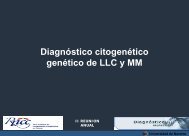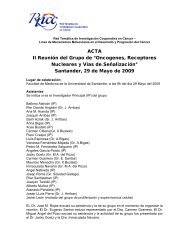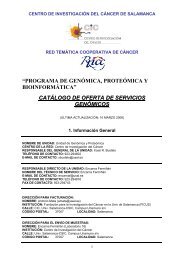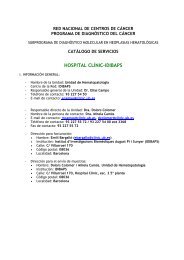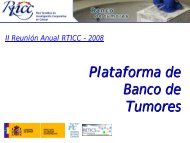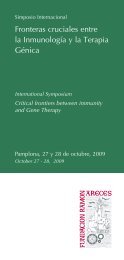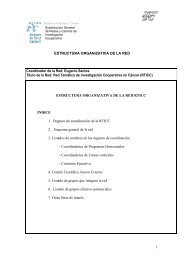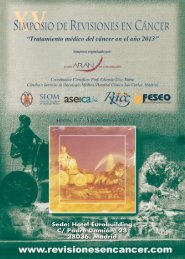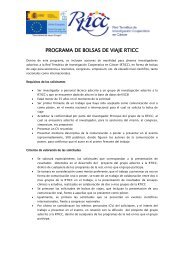Untitled - Red Temática de investigación cooperativa en cáncer
Untitled - Red Temática de investigación cooperativa en cáncer
Untitled - Red Temática de investigación cooperativa en cáncer
Create successful ePaper yourself
Turn your PDF publications into a flip-book with our unique Google optimized e-Paper software.
P-14<br />
AICAR INDUCES BAK/BAK-DEPENDENT APOPTOSIS THROUGH UP-REGU-<br />
LATION OF THE BH3-ONLY PROTEINS BIM AND NOXA IN MOUSE EMBRYO<br />
FIBROBLASTS<br />
MONCUNILL-MASSAGUER C 1 , GONZÁLEZ-GIRONÈS D 1 ,IGLESIAS-SERRET D 1 , COSIALLS AM 1<br />
PÉREZ-PERARNAU A 1 , MARIELA-PALMERI C 1 , RUBIO-PATIÑO C 1 , VIOLLET B 2 , PONS G 1 , VILLUNGER<br />
A 3 , GIL J 1<br />
1<br />
DEPARTAMENT DE CIÈNCIES FISIOLÒGIQUES II, INSTITUT D’INVESTIGACIÓ BIOMÈDICA DE<br />
BELLVITGE (IDIBELL)–UNIVERSITAT DE BARCELONA, L’HOSPITALET DE LLOBREGAT, CATALUNYA,<br />
(RD06/0020/0097)<br />
2<br />
INSTITUT COCHIN, UNIVERSITÉ PARIS DESCARTES, CENTRE NATIONAL DE LA RECHERCHE SCIENTI-<br />
FIQUE (CNRS), PARIS, FRANCE<br />
3<br />
DIVISION OF DEVELOPMENTAL IMMUNOLOGY, BIOCENTER, INNSBRUCK MEDICAL UNIVERSITY,<br />
INNBRUCK, AUSTRIA<br />
AICAR triggers apoptosis in<strong>de</strong>p<strong>en</strong><strong>de</strong>ntly of AMPK and p53 through the upregulation of the<br />
BH3-only proteins BIM and NOXA in chronic lymphocytic leukemia (CLL) cells. However,<br />
it remains unknown how AICAR treatm<strong>en</strong>t modulates the expression of these BH3-only<br />
proteins.<br />
Here we propose mouse embryonic fibroblasts (MEFs) as a useful mo<strong>de</strong>l to analyze the<br />
mechanism of AICAR-induced apoptosis. ZMP formation is required for AICAR-induced<br />
apoptosis and it activates its main target Ampk. Nevertheless, direct Ampk activation with<br />
A-769662 failed to induce apoptosis in MEFs, and AICAR also pot<strong>en</strong>tly induced apoptosis<br />
in Ampkα1-/-/α2-/- MEFs, <strong>de</strong>monstrating an Ampk-in<strong>de</strong>p<strong>en</strong><strong>de</strong>nt mechanism of cell <strong>de</strong>ath.<br />
Notably, MEFs double knockouot for Bax and Bak were completely resistant to the apoptosis<br />
triggered by AICAR, confirming the involvem<strong>en</strong>t of the mitochondrial pathway in its mechanism<br />
of action. Apoptosis was precee<strong>de</strong>d by ZMP-<strong>de</strong>p<strong>en</strong><strong>de</strong>nt but Ampk-in<strong>de</strong>p<strong>en</strong><strong>de</strong>nt modulation<br />
of mRNA levels of differ<strong>en</strong>t Bcl-2 family members, including Noxa, Bim and Bcl-2.<br />
Bim protein levels are accumulated by AICAR treatm<strong>en</strong>t of MEF cells, suggesting its role in<br />
the apoptotic process. Strikingly, MEFs lacking both Bim and Noxa display high resistance to<br />
AICAR, in concordance with their requirem<strong>en</strong>t for AICAR-induced cell <strong>de</strong>ath B lymphocytes.<br />
Overall, we <strong>de</strong>monstrate that AICAR mechanism of apoptosis is highly similar in MEFs,<br />
mouse B lymphocytes and CLL cells and thus MEFs will be used for the complete elucidation<br />
of AICAR-induced apoptosis mechanism.<br />
P-15<br />
DETERMINATION OF SNAIL1 PARACRINE FUNCTIONS: IMPLICATION<br />
IN PRO-TUMOROGENIC ABILITIES ON COLORECTAL EPITHELIAL CELLS<br />
LINES<br />
HERRERA-TEJERO A 1 , HERRERA-TORRES M 1 ,GARCÍA DE HERREROS A 1 , BONILLA-VELASCO<br />
F 1 , PEÑA-MAROTO 1<br />
1<br />
HOSPITAL UNIV. PUERTA HIERRO-MAJADAHONDA (RD06/0020/0020)<br />
Experim<strong>en</strong>tal data support the i<strong>de</strong>a that the active recruitm<strong>en</strong>t of stromal cells by tumor<br />
cells is ess<strong>en</strong>tial for the g<strong>en</strong>eration of a micro<strong>en</strong>vironm<strong>en</strong>t that actively fosters tumor<br />
growth. Snail1 is a transcriptional factor that plays an important role in epithelial-mes<strong>en</strong>chymal<br />
transition (EMT)-mediated metastasis through the regulation of E-Cadherin expression.<br />
E-Cadherin is downregulated in human colon epithelial cells wh<strong>en</strong> co-cultured with Snail1<br />
expressing cells. Moreover, expression of Snail1 in the tumor stroma correlates with lower<br />
specific survival of cancer pati<strong>en</strong>ts. The aim of this study was to <strong>de</strong>termine the possible<br />
pro-tumorog<strong>en</strong>ic paracrine functions of Snail1 expressing cells.<br />
Cancer-Associated Fibroblasts (CAFs) and Normal Fibroblasts (NFs) were isolated from 15<br />
primary human colon tumors and 5 normal mucosa respectively. Colon cancer cell lines<br />
SW480-ADH or LIM1215 were co-cultured with a panel of Snail1 expressing colon and<br />
fibroblasts cell lines, or primary CAFs, to study migration and proliferation changes. Coculture<br />
analyses were <strong>de</strong>veloped using trans-well culture system. Proliferation assays were<br />
also analyzed with conditioned medium from fibroblasts and CAFs. The Snail1 expressing<br />
cell lines induced higher cell migration of SW480-ADH or LIM1215 compared with Mock<br />
cells. Moreover, increase of proliferation in<strong>de</strong>x in SW480-ADH cells were observed wh<strong>en</strong><br />
co-cultured with Snail1 expressing cells. In both migration and proliferation, the effect was<br />
higher wh<strong>en</strong> Snail1 was expressed by fibroblasts, regarding tumor colon cells. Analysis of<br />
primary CAFs showed higher Snail expression levels in CAFs compared with NFs. Interestingly,<br />
co-culture of CAFs with LIM1215 or SW480-ADH cells induced a significant increase in<br />
epithelial cell migration, as well as in proliferation, associated with Snail expression.<br />
Together, these experim<strong>en</strong>ts <strong>de</strong>monstrate the Snail1-<strong>de</strong>p<strong>en</strong><strong>de</strong>nt paracrine pro-tumorog<strong>en</strong>ic<br />
effects of fibroblasts on colon cancer cells. Future analysis will inclu<strong>de</strong> cytokine profile study<br />
of Snail1 expressing cells, as well as primary CAFs and NFs, to characterize the cross-talk<br />
betwe<strong>en</strong> colorectal cancer cells and fibroblasts.<br />
58 59



